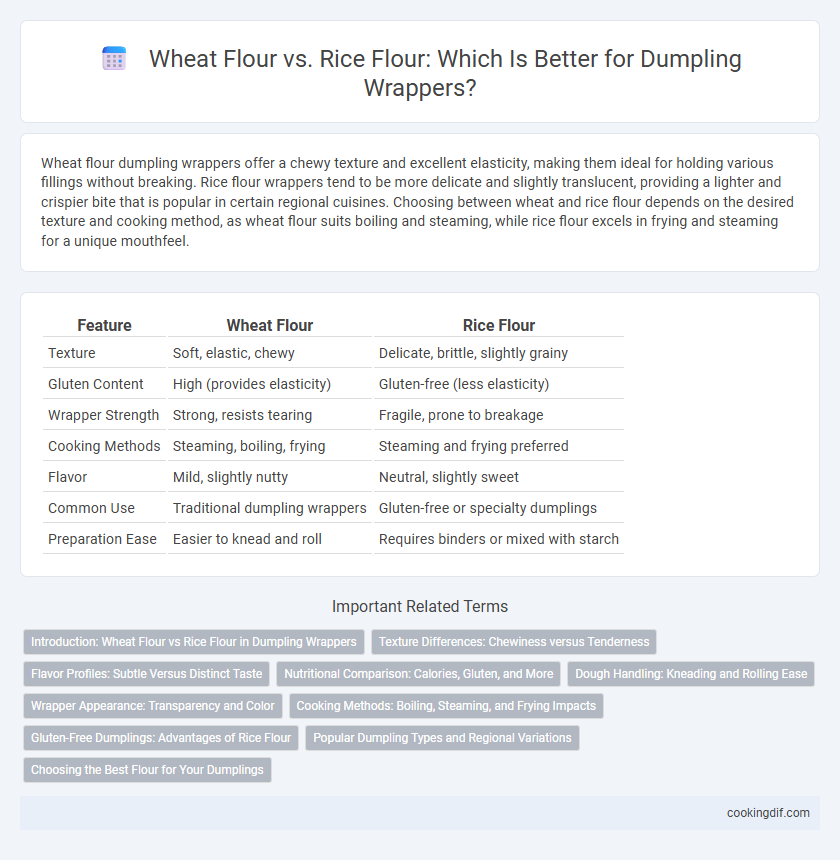Wheat flour dumpling wrappers offer a chewy texture and excellent elasticity, making them ideal for holding various fillings without breaking. Rice flour wrappers tend to be more delicate and slightly translucent, providing a lighter and crispier bite that is popular in certain regional cuisines. Choosing between wheat and rice flour depends on the desired texture and cooking method, as wheat flour suits boiling and steaming, while rice flour excels in frying and steaming for a unique mouthfeel.
Table of Comparison
| Feature | Wheat Flour | Rice Flour |
|---|---|---|
| Texture | Soft, elastic, chewy | Delicate, brittle, slightly grainy |
| Gluten Content | High (provides elasticity) | Gluten-free (less elasticity) |
| Wrapper Strength | Strong, resists tearing | Fragile, prone to breakage |
| Cooking Methods | Steaming, boiling, frying | Steaming and frying preferred |
| Flavor | Mild, slightly nutty | Neutral, slightly sweet |
| Common Use | Traditional dumpling wrappers | Gluten-free or specialty dumplings |
| Preparation Ease | Easier to knead and roll | Requires binders or mixed with starch |
Introduction: Wheat Flour vs Rice Flour in Dumpling Wrappers
Wheat flour and rice flour serve distinct roles in crafting dumpling wrappers, each influencing texture and taste uniquely. Wheat flour provides elasticity and chewiness due to its higher gluten content, ideal for traditional dumplings requiring pliable wrappers. Rice flour, gluten-free and finer, produces tender, slightly brittle skins that suit steamed or boiled dumplings with delicate fillings.
Texture Differences: Chewiness versus Tenderness
Wheat flour dumpling wrappers create a chewy texture due to their high gluten content, providing elasticity and a satisfying bite. Rice flour wrappers result in a tender, delicate texture with less chewiness, making them ideal for lighter, softer dumplings. Selecting wheat or rice flour significantly affects the mouthfeel, influencing the overall dumpling experience and complementing different fillings and cooking methods.
Flavor Profiles: Subtle Versus Distinct Taste
Wheat flour dumpling wrappers offer a mild, neutral flavor that complements a wide range of fillings without overpowering them, making them a versatile choice in many traditional recipes. Rice flour wrappers provide a distinct, slightly nutty taste that can enhance the filling's flavor, adding a unique dimension especially suited for lighter or seafood-based dumplings. The subtlety of wheat flour allows the filling to be the star, while rice flour introduces a noticeable yet pleasant flavor contrast in the overall taste experience.
Nutritional Comparison: Calories, Gluten, and More
Wheat flour dumpling wrappers typically contain higher calories and gluten, which provide elasticity and a chewy texture, essential for traditional dumplings. In contrast, rice flour wrappers are lower in calories and gluten-free, making them suitable for gluten-intolerant individuals but often result in a more delicate, slightly gritty texture. Nutritionally, wheat flour offers more protein and B vitamins, while rice flour is typically easier to digest and contains fewer allergens.
Dough Handling: Kneading and Rolling Ease
Wheat flour dumpling wrappers offer superior elasticity and strength, making kneading and rolling smoother and less prone to tearing. Rice flour dough tends to be more fragile and requires gentler handling, often leading to a more delicate wrapper that can break easily during preparation. Choosing wheat flour enhances dough elasticity, facilitating efficient shaping and consistent thickness in dumpling wrappers.
Wrapper Appearance: Transparency and Color
Wheat flour dumpling wrappers typically exhibit a slightly opaque and off-white appearance, offering a smooth and pliable texture ideal for folding. Rice flour wrappers are known for their translucent and glossy finish, providing a delicate, glass-like look that highlights the filling within. The choice between wheat and rice flour directly influences the dumpling's visual appeal, with rice flour enhancing transparency and wheat flour delivering a more solid, traditional aesthetic.
Cooking Methods: Boiling, Steaming, and Frying Impacts
Wheat flour dumpling wrappers maintain elasticity and a chewy texture during boiling, steaming, and frying due to their gluten content, which creates a stretchy dough that holds shape and moisture well. Rice flour wrappers, lacking gluten, result in a more delicate, slightly brittle skin that is tender when steamed but may crack or become overly soft when boiled or fried. Choosing between wheat and rice flour affects dumpling durability and texture, with wheat flour preferred for frying and boiling, while rice flour excels in steamed preparations that require a lighter, more fragile wrapper.
Gluten-Free Dumplings: Advantages of Rice Flour
Rice flour offers a gluten-free alternative essential for dumpling wrappers, catering to individuals with gluten intolerance or celiac disease. Unlike wheat flour, rice flour creates a tender, slightly chewy texture ideal for delicate dumplings without triggering allergic reactions. Its neutral flavor enhances the filling's taste, making rice flour the preferred choice for health-conscious and gluten-sensitive consumers.
Popular Dumpling Types and Regional Variations
Wheat flour is predominantly used in Northern Chinese dumplings like jiaozi and baozi, where the dough requires elasticity to create a chewy texture. Rice flour is favored in Southern Chinese regions for dishes like cheung fun and har gow, providing a delicate, translucent wrapper that complements the light fillings. Regional variations highlight how wheat flour suits robust dumplings, while rice flour enhances steamed dim sum with its soft, tender layers.
Choosing the Best Flour for Your Dumplings
Wheat flour is preferred for dumpling wrappers due to its high gluten content, which provides elasticity and a chewy texture essential for shaping and cooking. Rice flour, while gluten-free and offering a lighter, more delicate wrapper, tends to be fragile and less pliable, making it challenging to work with for traditional dumpling folding. Selecting the best flour depends on the desired texture and dietary needs, with wheat flour ideal for classic dumplings and rice flour suitable for gluten-sensitive diets or thinner, crispier skins.
Wheat flour vs rice flour for dumpling wrappers Infographic

 cookingdif.com
cookingdif.com